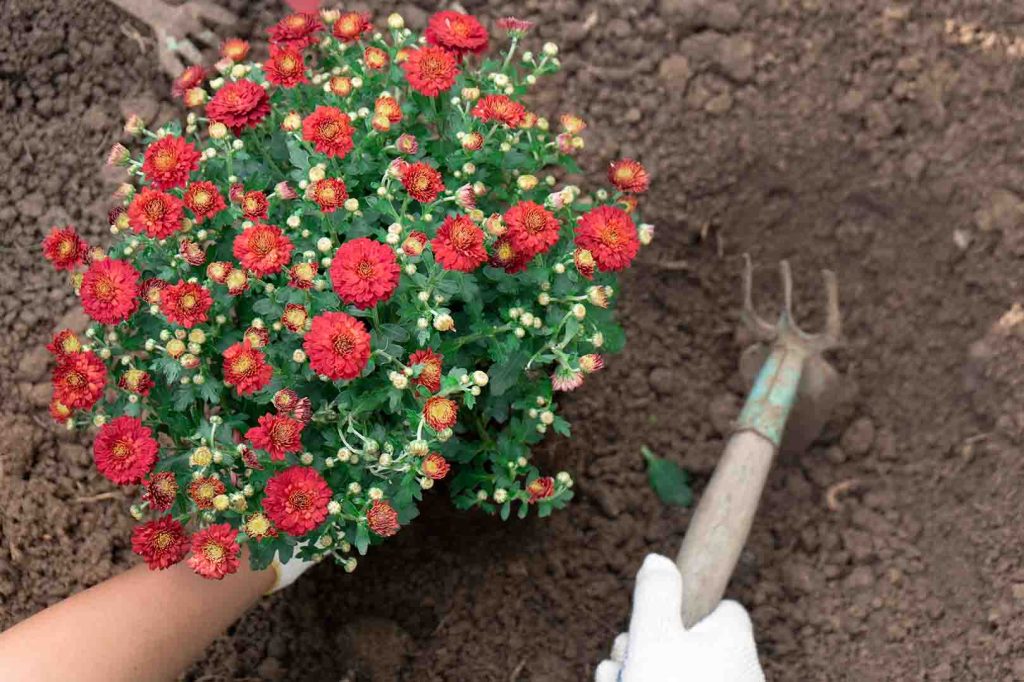
When it comes to fall flowers, there’s nothing quite as iconic as chrysanthemums! These beautiful blooms come in a variety of colors and can be grown just about anywhere. Join the Tuxedo team as we explore when mums grow grow, the types of mums, how to care for them, and more!
What Are Mums?

Chrysanthemums, or “mums” as they are affectionately referred to, are a flowering plant of the Asteraceae family. They are native to Asia, especially in China and Japan, but they have become popular worldwide due to their vibrant colors and cheerful blooms. Mums bloom between late summer and fall, typically between September and November, making them a great addition to any autumn garden.
Mums are perennial by nature, but they often behave as annual plants because many of them do not survive the first winter. Over the years, mums have become a staple of any autumn decorating plan. They come in a variety of colors, shapes, and sizes, so you’re sure to find the perfect mum (or mums) for your garden or home!
How To Identify Mums

Mums are easy to identify because of their distinctive daisy-like petals and vibrant colors. The Asteraceae family includes such flowers as daisies and sunflowers, which usually have similar petals and central discs. Most mums feature a central disc surrounded by several rings of petals that come in a variety of shapes and sizes. The most popular colors for mums are yellow, white, red, bronze, pink, and orange, but you can sometimes find more rare colors like blue or purple.
Common types of mums include single-flowered and double-flowered varieties, some of the most popular of which are called pompon, daisy, spider, and cushion types. Other types are hardy perennial species, annuals, and even evergreen species.
Key Characteristics:
- Colorful petals
- Large central disks
- Rounded blooms
- Closely clustered florets
- Dark leaves and stems
Potted Or Planted?

The reason mums are so popular for autumn decoration is not only that they bloom in fall; people also love how versatile they are! Mums are famous for being adaptable to pots, gardens, indoors, outdoors, and wherever else you want to put them! However, you have to make sure you read packaging labels closely, because some mums perform better in pots and some perform better in gardens.
- Florist Mums are your typical “decorative” mums that start popping up all over nurseries and stores as fall arrives. Florist mums are best left in pots and/or indoors because they have weaker roots that produce few underground runners. If planted outdoors, florist mums will act as annual plants because they typically can not survive the winter. Planted florist mums are usually discarded every year.
- Garden Mums are also known as hardy mums because they are stronger and longer-lasting than florist mums. Garden mums are better suited to outdoor environments, with roots that will spread deeper and wider than florist mums. If planted correctly and given the right care, garden mums will come back every year for you to enjoy!
Plant Your Garden Mums In Spring!

Though everyone knows mums as the fall flower, you should plant garden mums in spring because it takes a while for their roots to get established. Mums have notoriously shallow roots, so it takes a little longer for them so spread out and get a good, firm hold in the soil. Planting mums in spring allows enough time for water and nutrients to be absorbed and roots to take hold before blooming starts in late summer and/or early fall.
- SKIP THE SEEDING! People rarely try to plant chrysanthemum seeds into their gardens because it is simply not as effective as transferring a garden mum from a nursery pot. However, make sure it is a garden mum you are planting and not a florist mum, as the florist mum will likely not survive in a crowded garden.
How To Care For Mums

Mums are relatively low-maintenance plants and can flourish in almost any type of soil, as long as it is well draining and free from weeds. When planting mums outdoors, make sure to give them plenty of sunlight and space — ideally, about 6 hours of sun per day. When watering your mums, make sure to do so regularly, but not too often because overwatering can lead to root rot and disease. When winter comes around, leaving just an inch or two of stem should help sprout new growth in mid-spring for any of your mums that survived winter!
Follow the steps below when caring for potted mums (florist types):
- Transfer mums to a larger pot with premium potting soil.
- Break apart compacted root balls from the nursery containers.
- Soak the soil ONLY after the initial repotting.
- Place potted mums near windows if they are indoors.
- Give indoor potted mums direct access to sunlight.
- Pinch off flowers, leaves, and stems as they start to wilt or die.
- Water at the base of the plant.
- Keep soil moist at all times but not soaked.
- Transfer mums to prepared, well-draining soil in your garden.
- Prepare soil by mixing it with 2 to 4 inches of organic compost.
- Plant garden mums up to 18 inches apart in direct sunlight.
- Pinch off wilting leaves and stems as needed.
- Water early in the morning to avoid fungal infection.
- Water every other day, up to an inch per week.
- Cover the soil with mulch to prepare for winter.



